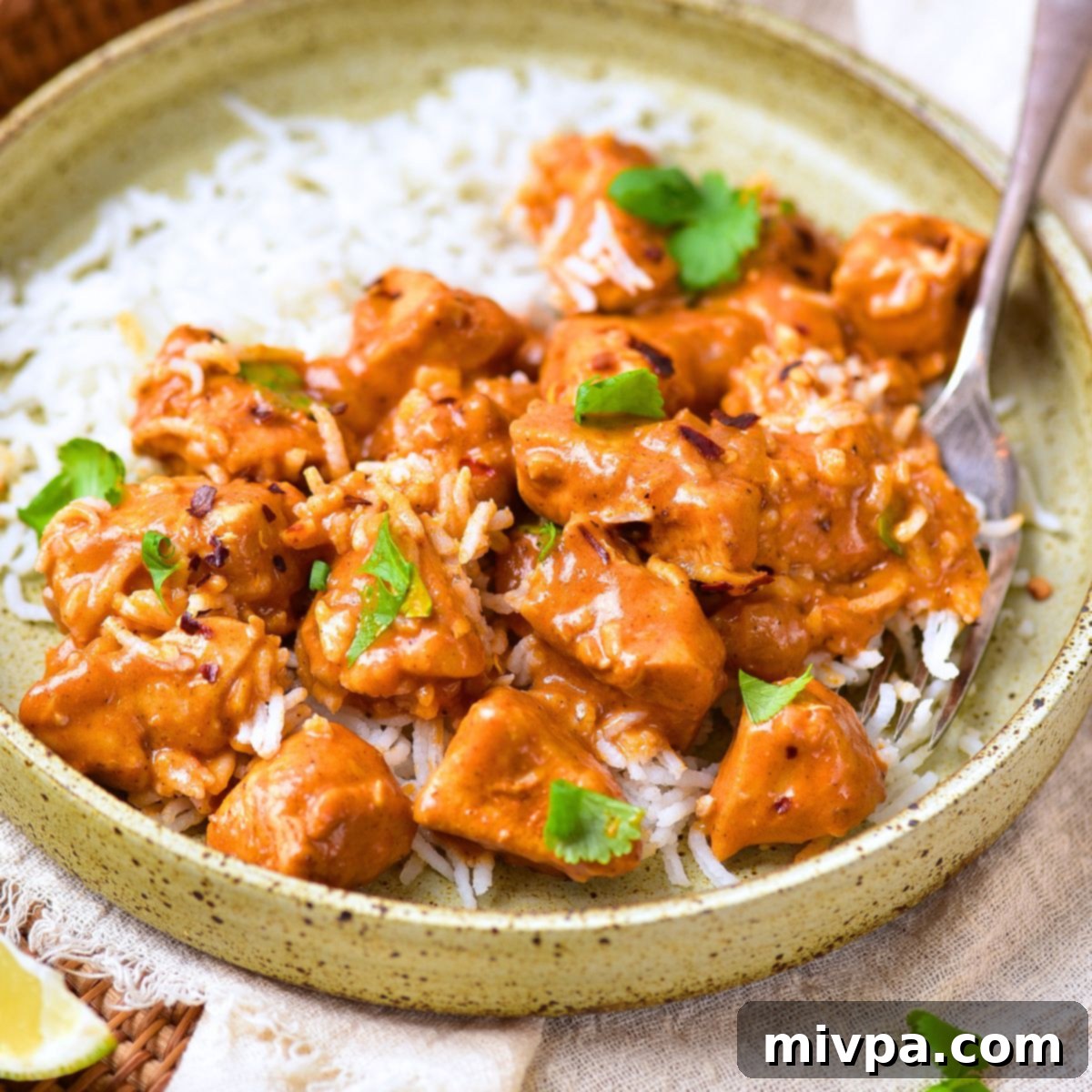Easy & Flavorful Gluten-Free Chicken Curry (Dairy-Free) – A Weeknight Comfort Meal
Mildly spicy and bursting with rich, aromatic flavors, this delicious gluten-free chicken curry is the perfect dish to whip up when you’re craving authentic Asian food. It’s not only incredibly satisfying but also entirely dairy-free, making it a fantastic option for those with dietary restrictions or anyone looking for a healthier alternative. Serve it hot with a generous portion of fluffy white rice, and get ready to be transported to a world of culinary delight!

Delicious Chicken Curry and Rice: A Taste of Home
For me, there’s nothing quite like the comforting embrace of a well-made curry to bring me back to my roots in Southeast Asia. The moment the blend of sautéed onions, garlic, and ginger hits the pan, followed by a symphony of warm spices, I’m instantly transported to the bustling hawker centers and vibrant kitchens of Singapore. It’s more than just a meal; it’s a nostalgic journey, a flavor memory that deeply resonates.
This rich, hot, and mildly spicy curry, ladled generously over a bed of perfectly steamed fluffy white rice, embodies everything I seek in comfort food. It’s hearty, aromatic, and profoundly satisfying, especially when I’m longing for the familiar tastes of home. Today, we’re sharing an incredibly easy yet deeply flavorful gluten-free chicken curry recipe that we’re confident will become a firm favorite among all Asian food lovers, whether you’re accustomed to these flavors or discovering them for the first time.
This recipe focuses on creating a robust and authentic taste profile using readily available ingredients. It celebrates the balance of savory, subtly sweet, and just the right amount of heat, all while catering to specific dietary needs. Prepare to impress your family and friends with this simple, wholesome, and utterly delicious chicken curry that truly captures the essence of Asian comfort cuisine.
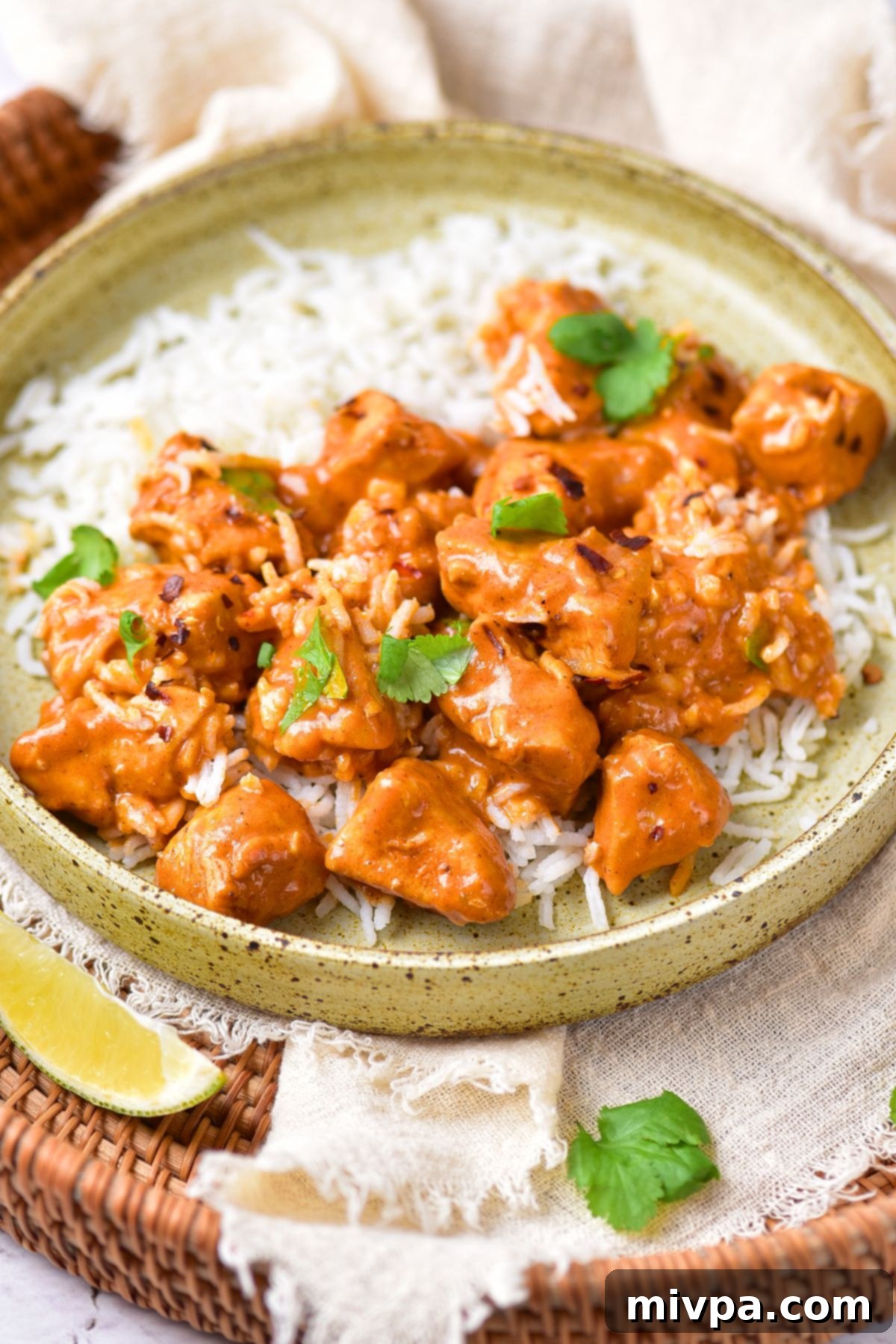
Why This Easy Gluten-Free Chicken Curry Recipe Works:
- Simple & Accessible Ingredients: You don’t need to embark on a scavenger hunt for exotic spices or specialty items. The core ingredients for this simple gluten-free chicken curry are staples you can easily find at your local grocery store. This makes it a stress-free meal to prepare on any given weeknight, ensuring that delicious, homemade Asian flavors are always within reach without requiring a trip to a specialty Asian market. We believe good food shouldn’t be complicated.
- Effortlessly Easy to Make: Don’t let the rich flavors intimidate you; making this gluten-free and dairy-free curry is surprisingly straightforward. The process involves just a few simple steps: sautéing the chicken cubes, then building the aromatic base with fresh vegetables and spices, followed by the addition of broth, tomato paste, and creamy coconut milk. Finally, a gentle simmer allows all the flavors to meld beautifully, resulting in a thick, creamy, and deeply satisfying curry with minimal fuss. It’s perfect for both novice cooks and seasoned home chefs alike.
- Naturally Gluten-Free & Dairy-Free: One of the standout features of this incredible curry chicken recipe is its natural suitability for various dietary needs. It is completely gluten-free and dairy-free, making it an ideal choice for individuals with Celiac disease, gluten sensitivities, or lactose intolerance. You can indulge in all the vibrant flavors and comforting textures of a traditional curry without any concerns or compromises on taste or quality. We use coconut milk to achieve that luscious creaminess, ensuring everyone can enjoy a bowl of this deliciousness.
- Rich, Authentic Flavor Profile: Despite its simplicity, this recipe doesn’t skimp on flavor. By building layers of aromatics, carefully selected spices, and the richness of full-fat coconut milk, we create a depth of flavor that tastes incredibly authentic and satisfying. The mild spice level ensures it’s palatable for most, while still delivering that quintessential curry warmth.
- Versatile and Adaptable: This chicken curry is incredibly versatile. It pairs wonderfully with a variety of sides, from classic white rice to cauliflower rice or gluten-free naan. You can also easily adjust the spice level to your preference, making it a customizable meal for the whole family.
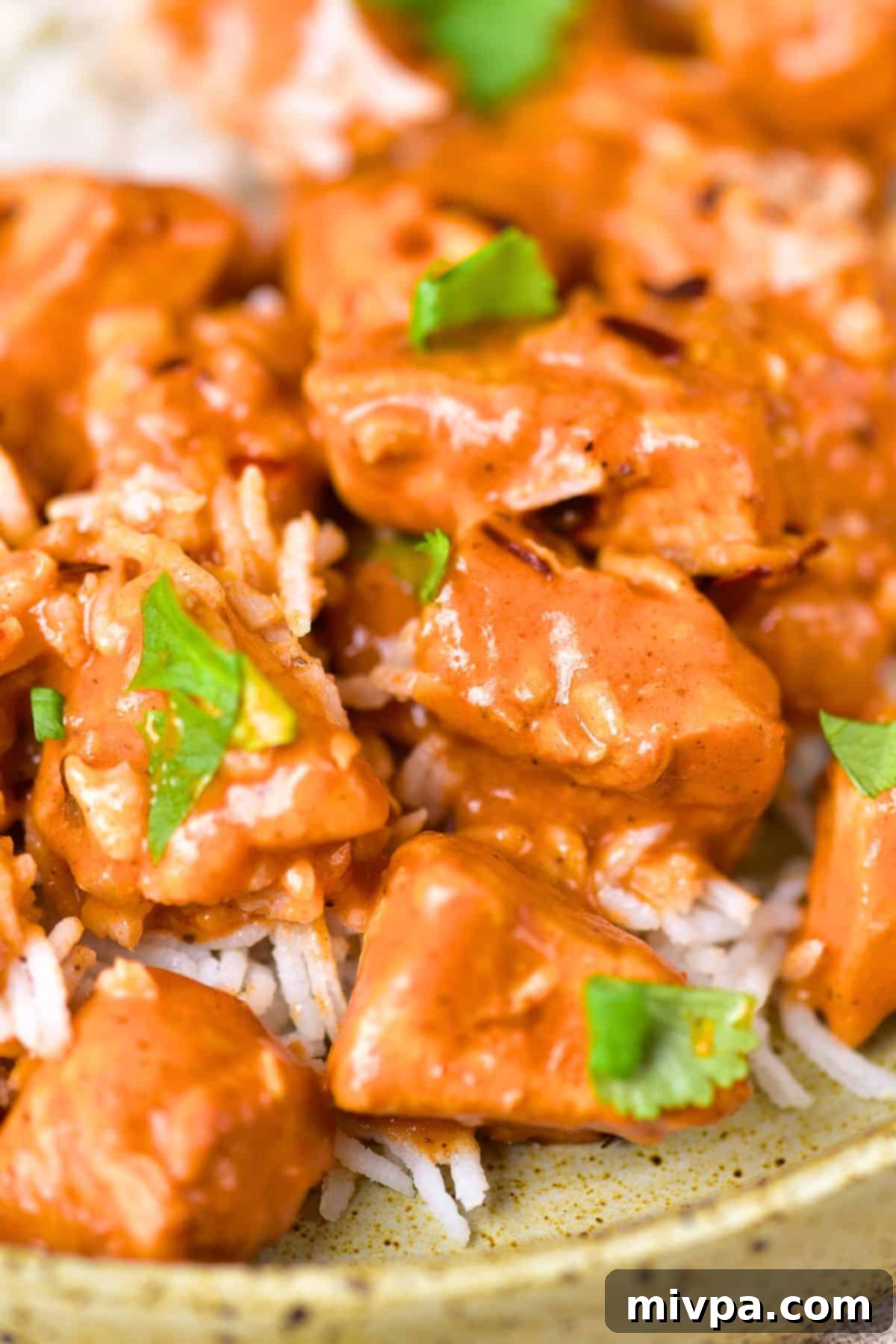
Essential Ingredients for Your Gluten-Free Chicken Curry:
To help you visualize what you’ll need, here’s an overview of the key ingredients required for making this mouthwatering gluten-free chicken curry recipe. Each component plays a vital role in building the incredible depth and flavor of the final dish. We recommend gathering all your ingredients before you start cooking to ensure a smooth and enjoyable culinary experience.
(For a precise list of exact measurements and quantities, please scroll down to the comprehensive printable recipe card conveniently located at the bottom of this post.)

Recipe Notes & Easy Substitutions to Customize Your Curry:
This recipe is designed to be flexible, allowing you to tailor it to your preferences and what you have on hand. Here are some detailed notes and potential substitutions for the ingredients:
- Olive Oil: I’ve opted for extra virgin olive oil for its rich flavor, but any neutral-flavored vegetable oil will work just as well. Options include sunflower oil, canola oil, avocado oil, or grapeseed oil. The goal is to provide a medium for sautéing without overpowering the curry’s delicate spices.
- Chicken: Boneless, skinless chicken breasts are used here for their lean profile and ease of cubing. However, for a juicier and richer texture, feel free to substitute with boneless, skinless chicken thighs. Thighs tend to hold up better during simmering and absorb flavors wonderfully. Just ensure they are cut into uniform cubes for even cooking.
- Fresh Aromatics (Onions, Garlic, Ginger): These three ingredients form the essential flavor base of almost any great Asian curry. Freshly diced onions, minced garlic, and grated ginger contribute incredible depth and an aromatic foundation that simply cannot be replicated with powders. Don’t skip these! They are truly the soul of the dish.
- Spice Blend: The heart of this delicious curry lies in its aromatic spice blend, which includes curry powder, ground coriander, ground black pepper, ground cumin, and ground paprika. This combination creates a balanced, warm, and flavorful profile. For those who enjoy more heat, a pinch of ground cayenne pepper or red pepper flakes can be added to taste. Feel free to adjust the quantities of each spice to suit your personal preference for intensity.
- Unsweetened Coconut Milk: For the best results and a truly thick, creamy, and dairy-free curry, I highly recommend using unsweetened full-fat coconut milk. The fat content contributes significantly to the luscious texture and rich flavor. If you are not lactose-intolerant and prefer a non-coconut option, plain Greek yogurt (full-fat for creaminess) can be used as an alternative, but note this will alter the flavor profile and make it no longer dairy-free. Always shake the can of coconut milk well before opening, or stir if the cream has separated.
- Broth: You have flexibility here! Use any low-sodium broth you have on hand – chicken broth, beef broth, or vegetable broth will all work beautifully. Opting for low-sodium allows you to control the overall saltiness of the dish, adding more if needed after tasting.
- Tomato Paste: Don’t underestimate the power of tomato paste! It’s a concentrated flavor enhancer that adds a subtle tang, umami depth, and a beautiful rich color to the curry. Make sure to sauté it briefly with the aromatics to deepen its flavor before adding liquids.
- Cornstarch: A small amount of cornstarch is included to help achieve a slightly thicker, more velvety consistency for the curry sauce. If you have a corn allergy or prefer to avoid it, you can simply omit it. In this case, allow the curry to simmer for an additional 5-10 minutes, stirring occasionally, until it naturally reduces and reaches your desired thickness. Another option is to use arrowroot powder as a substitute, using the same quantity.
- Other Vegetables: For added nutrition and texture, consider incorporating other vegetables like diced bell peppers, carrots, potatoes (add earlier for full cooking), or spinach (stir in at the end).
How to Make Easy Gluten-Free Chicken Curry (Step by Step Guide):
Creating this flavorful gluten-free and dairy-free chicken curry is a straightforward process. Follow these simple steps for a perfect dish every time:
1. Sauté the Chicken Cubes to Golden Perfection
Begin by heating the olive oil in a large skillet or Dutch oven over medium heat. Once shimmering, add the cubed chicken pieces. Sauté for approximately 7 minutes, stirring occasionally to ensure all sides of the chicken are lightly browned and just cooked through. The goal here is to sear the chicken, locking in its juices and adding a layer of flavor, not to cook it entirely. This initial browning contributes significantly to the final taste. Once cooked, remove the chicken from the skillet and set it aside on a plate; it will finish cooking later in the curry sauce.
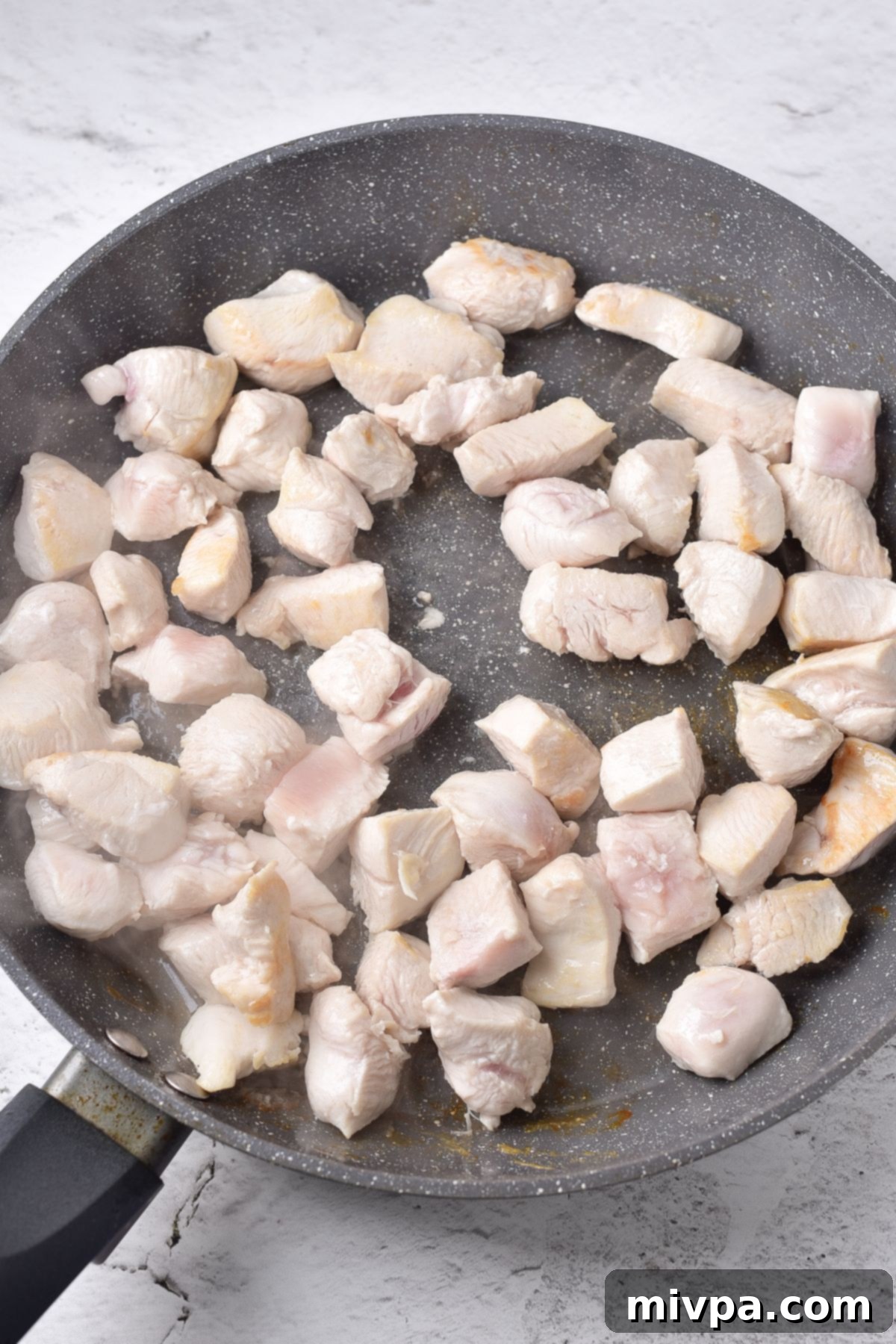
2. Build the Aromatic Base with Onions, Garlic, Ginger, and Spices
In the same skillet (add a little more oil if needed), add the diced onion. Sauté for about 4 minutes, stirring regularly until the onions soften and become translucent. This step is crucial for developing the foundational sweetness of the curry. Next, stir in the minced garlic and grated ginger, along with the salt and the entire spice blend (curry powder, ground coriander, black pepper, cumin, and paprika). Continue to cook on low heat for another 3 minutes, stirring constantly. This “blooms” the spices in the hot oil, releasing their full aromatic potential and infusing the base with incredible flavor. Be careful not to burn the garlic or spices. Once the aromatic base is fragrant and rich, return the previously sautéed chicken back to the skillet, tossing to coat it with the fragrant mixture.

3. Simmer to Perfection: Infusing Flavors and Thickening the Sauce
Now, it’s time to bring the curry together. Pour in the chicken broth, stir in the tomato paste, and add the full-fat coconut milk for its signature creaminess. If you’re using cornstarch to thicken, whisk it in now to ensure no lumps. Stir everything well to combine, then bring the mixture to a gentle simmer. Reduce the heat to low, cover the skillet, and allow the curry to simmer for a minimum of 20 minutes. This simmering period is essential: it allows the chicken to become incredibly tender, the flavors to meld and deepen beautifully, and the sauce to thicken to a luxurious consistency. Check the curry periodically; if it becomes too thick for your liking, you can always add a little more broth or coconut milk, a tablespoon at a time, until it reaches your desired consistency. Taste and adjust seasoning as needed.
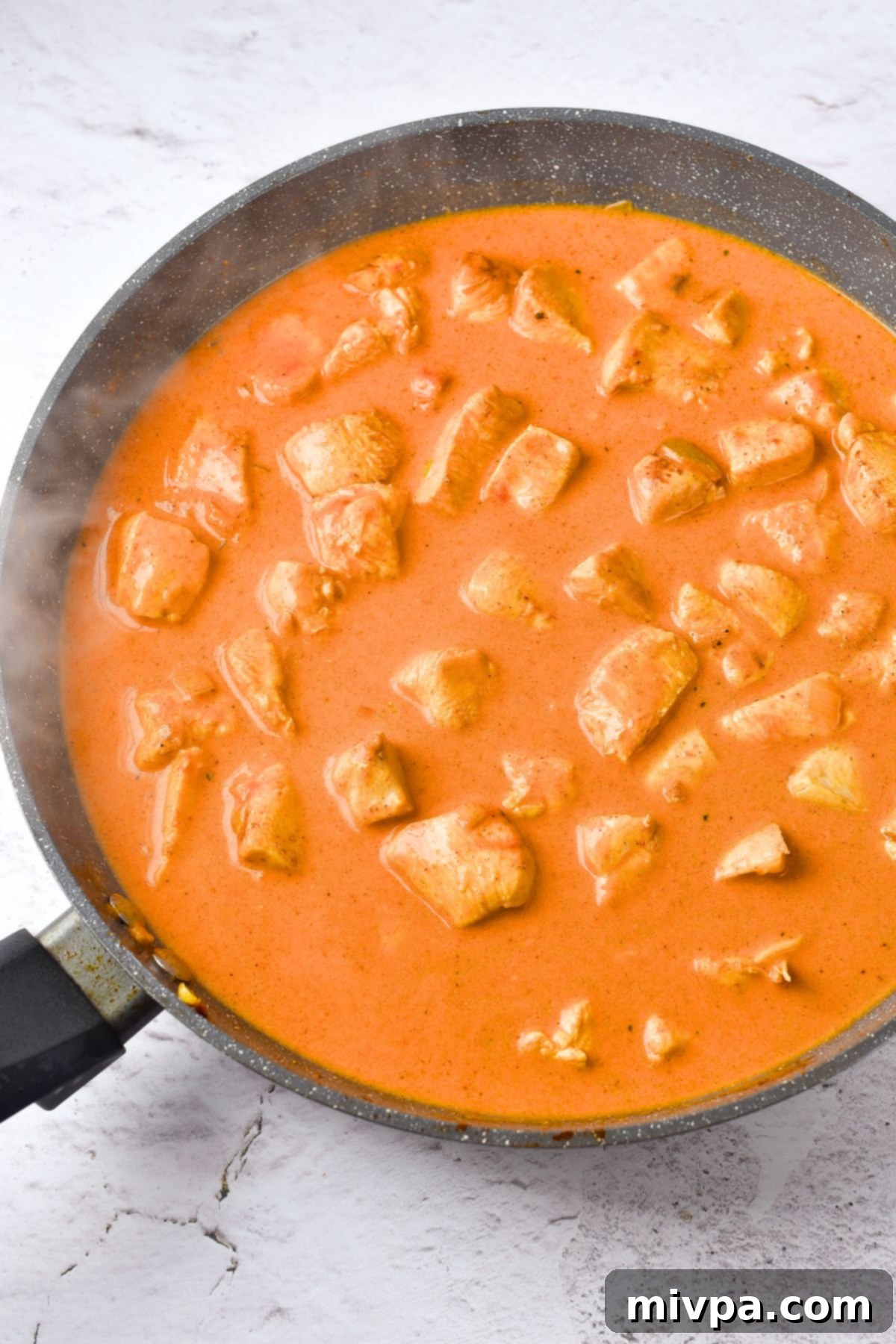
4. Serve Hot and Savor the Flavors!
Once your gluten-free coconut chicken curry has reached its perfect consistency and the chicken is fork-tender, it’s ready to be served! Ladle generous portions over a bed of freshly steamed white rice – jasmine or basmati rice are excellent choices that complement the curry beautifully. For an extra pop of color and freshness, garnish with a sprinkle of fresh cilantro before serving. This final touch brightens the dish and adds another layer of aromatic appeal. Get ready to enjoy a truly comforting and flavorful meal that’s perfect for any occasion.
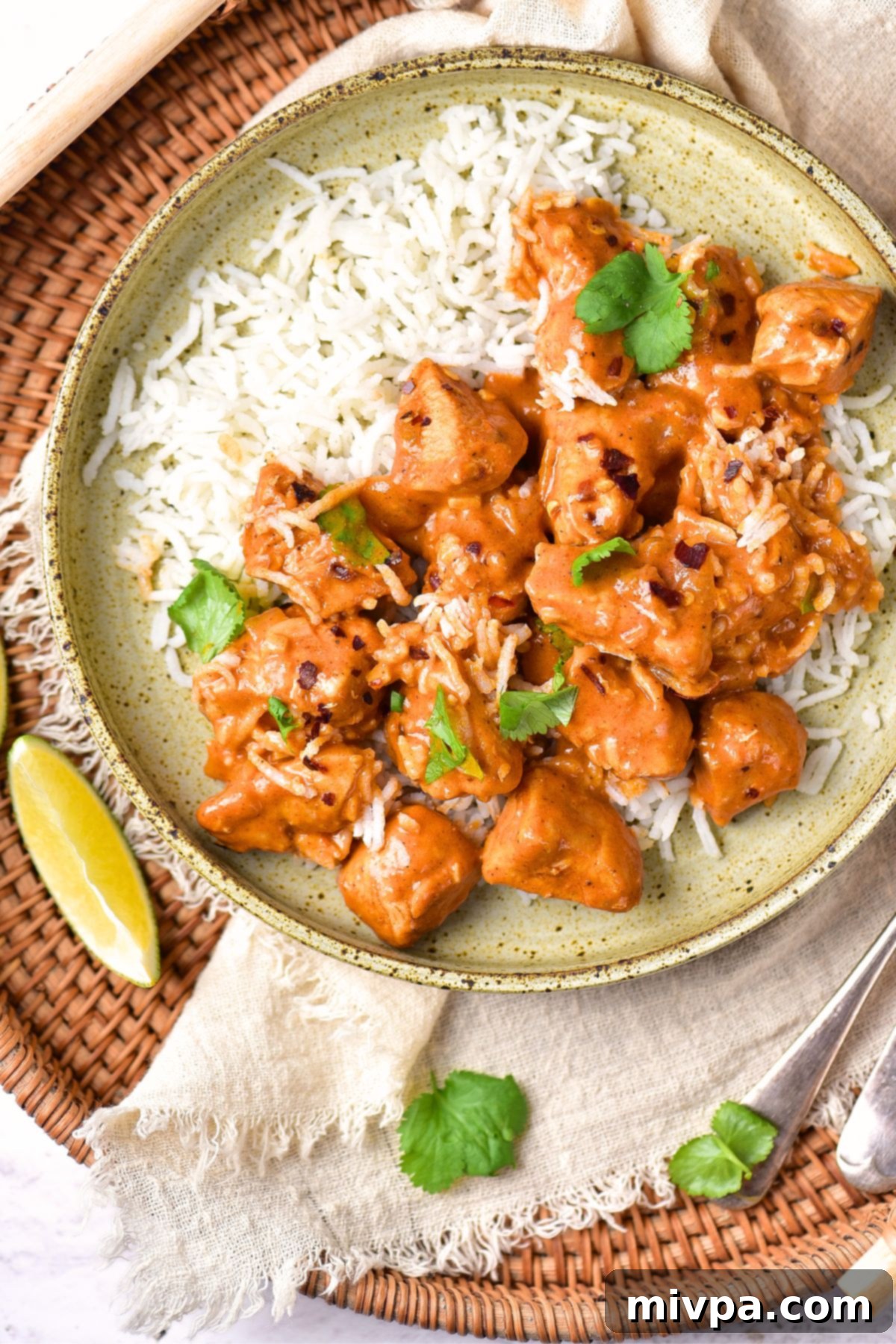
Dish by Dish Tips & Tricks for the Perfect Gluten-Free Curry:
- Swap Out Chicken for Other Protein: This gluten-free curry base is incredibly versatile! If chicken isn’t your preference, feel free to substitute it with other animal proteins or even plant-based options. Fish fillets (add towards the end of simmering as they cook faster), pork, lamb, or beef (braising cuts would be best for longer simmering) work wonderfully. For a vegetarian or vegan version, use chickpeas, lentils, firm tofu cubes, or a mix of hearty vegetables like cauliflower, potatoes, and bell peppers. Adjust cooking times accordingly based on the protein chosen.
- Make it Spicier (or Milder): The current recipe offers a mild spice level. If you enjoy more heat, increase the amount of red pepper flakes or add a pinch of cayenne pepper with the other spices. For a milder version, you can reduce the curry powder slightly or skip the chili entirely.
- Storing & Reheating: To store any leftover gluten-free curry chicken, transfer it to an airtight container and refrigerate for up to 3 days. Curry often tastes even better the next day as the flavors have more time to meld! To reheat, gently warm the curry in a saucepan on the stovetop over medium-low heat, stirring occasionally, until heated through. You can also use a microwave-safe dish and heat in 1-minute intervals, stirring in between. If the curry has thickened too much in the fridge, add a splash of broth or coconut milk when reheating.
- Freezing for Later: This chicken curry freezes beautifully! Once completely cooled, transfer portions into freezer-safe airtight containers or heavy-duty freezer bags. It can be stored in the freezer for up to 3 months. Thaw overnight in the refrigerator before reheating on the stovetop or in the microwave. Freezing makes it an excellent meal-prep option for busy days.
- Perfect Pairings: While this gluten-free curry chicken is delicious simply enjoyed over a bed of cooked rice (brown rice, fluffy white rice, basmati rice, or fragrant jasmine rice), don’t limit yourself! It also pairs wonderfully with tasty gluten-free naan bread for scooping up every last drop of sauce, or with cauliflower rice for a low-carb option. Consider serving it with a simple side salad or steamed green beans for a complete meal.
- Boost of Freshness: A squeeze of fresh lime juice stirred in at the very end can brighten all the flavors beautifully. Fresh cilantro is also a fantastic garnish that adds a burst of freshness.
More Delicious Gluten-Free Asian Dishes to Make:
If you’re loving the flavors of this gluten-free chicken curry, you’ll be thrilled to explore more of our easy-to-make, dietary-friendly Asian recipes. Expand your culinary repertoire with these other fan favorites:
- Kung Pao Chicken (Gluten-Free, Dairy-Free) – A classic with a healthy twist!
- Bang Bang Shrimp (Gluten-Free, Dairy-Free) – Crispy, creamy, and irresistible.
- Chicken Pho (Gluten-Free, Dairy-Free) – A comforting and aromatic noodle soup.
- Orange Chicken (Gluten-Free, Dairy-Free) – Sweet, tangy, and much healthier than takeout.
- Cashew Chicken (Gluten-Free, Dairy-Free) – A stir-fry favorite packed with flavor and crunch.
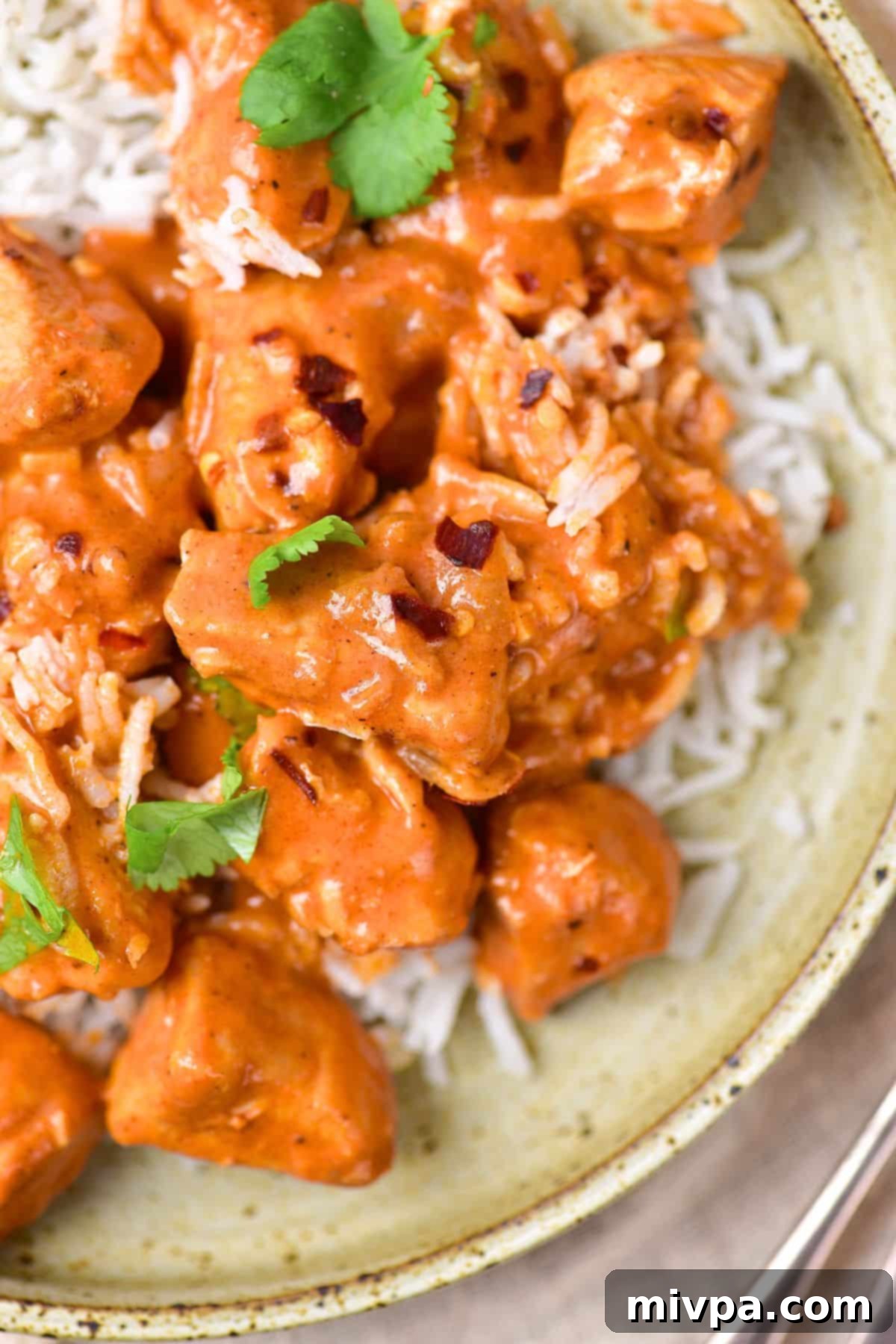
Other Gluten-Free Chicken Recipes You’ll Enjoy:
Looking for more ways to enjoy chicken that fits a gluten-free lifestyle? Here are some other fantastic chicken recipes that are sure to delight your taste buds and simplify your meal planning:
- Baked Chicken Legs and Potatoes (Gluten-Free, Dairy-Free)
- Mexican Chicken Meatballs (Gluten-Free, Dairy-Free)
- Easy Chicken Satay with Peanut Sauce (Gluten-Free, Dairy-Free)
- Crispy Cornflake Chicken Strips (Gluten-Free, Dairy-Free)
P.S. If you try this incredible gluten-free chicken curry recipe, we’d absolutely love to hear from you! Please consider leaving a star rating below and/or a detailed review in the comment section further down the page. Your feedback is invaluable and helps us create even better content for you. Don’t forget to explore our entire Recipe Index for a treasure trove of delicious and diverse recipes. You can also connect with us and share your culinary creations on Pinterest, Facebook, or Instagram! Make sure to sign up for our Email List to receive fresh, exciting recipes directly in your inbox each week!
Print

Gluten-Free Chicken Curry (Dairy-Free)
5 Stars 4 Stars 3 Stars 2 Stars 1 Star
5 from 3 reviews
Author: Felicia Lim
Total Time: 45 minutes
Yield: 4 servings
Diet: Gluten Free
Description
Mildly spicy, this delicious gluten-free chicken curry is perfect with fluffy white rice when you’re craving Asian food! It’s a comforting, aromatic, and easy-to-make dish that caters to specific dietary needs by being totally dairy-free too! Enjoy the authentic flavors of a classic curry without any compromise.
Ingredients
Units
Scale
- 12 oz. boneless skinless chicken breasts, cubed
- 1 onion, diced (medium-sized)
- 1 teaspoon grated fresh ginger
- 2 cloves garlic, minced (approximately 1 teaspoon)
- 1/3 cup full-fat coconut milk (from a can, shaken well)
- 1 cup low-sodium broth (chicken, vegetable, or beef)
- 2 tablespoons olive oil (extra virgin or other neutral oil)
- 1/2 teaspoon salt (or to taste, start with less and add more if needed)
- 1/2 teaspoon curry powder
- 1/2 teaspoon ground coriander
- 1/2 teaspoon ground black pepper
- 1/3 teaspoon ground cumin
- 1/2 teaspoon ground paprika
- 1 tablespoon tomato paste
- 1 teaspoon cornstarch (optional, for thickening)
- Optional garnish: Fresh cilantro, chopped
Instructions
- Sauté Chicken Cubes: Heat the olive oil in a large skillet or Dutch oven over medium heat. Add the cubed chicken breasts and sauté for about 7 minutes, stirring occasionally. Cook until the chicken is lightly browned on all sides and just cooked through the exterior. This step helps to lock in flavor and create a nice texture. Once done, remove the chicken from the skillet and set it aside on a clean plate.
- Cook Aromatics and Spices: In the same skillet, add the diced onions (add a tiny bit more oil if the pan is dry). Sauté for 4 minutes, stirring until the onions become tender and translucent. Next, add the minced garlic, grated ginger, salt, and all the dry spices (curry powder, ground coriander, ground black pepper, ground cumin, and ground paprika). Stir continuously and cook for an additional 3 minutes on low heat. This process, known as “blooming” the spices, deeply enhances their flavor and aroma. Return the sautéed chicken back into the skillet, tossing gently to coat it evenly with the fragrant spice mixture.
- Simmer the Curry: Pour in the low-sodium broth, stir in the tomato paste, and add the full-fat coconut milk. If you are using cornstarch for thickening, sprinkle it over the mixture and stir well to ensure there are no lumps. Bring the curry to a gentle simmer, then reduce the heat to low. Cover the skillet and let it cook for 20 minutes. This allows the chicken to become tender and for all the flavors to fully meld. During simmering, if the coconut curry begins to thicken more than desired, stir in a little more broth or coconut milk until it reaches your preferred consistency. Taste and adjust seasoning as needed.
- Serve and Enjoy: Once the curry is rich, creamy, and the chicken is perfectly tender, remove it from the heat. Serve the hot coconut chicken curry generously over a bed of fluffy steamed white rice. For an added touch of freshness and vibrant color, garnish with a sprinkle of freshly chopped cilantro. Enjoy this wonderfully comforting and flavorful gluten-free and dairy-free meal!
Notes
Olive Oil: I used extra virgin olive oil for its quality, but any neutral-flavored cooking oil will work well. Consider options like sunflower oil, canola oil, or avocado oil, which have higher smoke points and minimal flavor impact on the curry.
Chicken: While skinless, boneless chicken breast is specified for its lean profile, boneless, skinless chicken thighs are an excellent alternative. Chicken thighs tend to be more flavorful and stay juicier during simmering, offering a richer texture to your curry.
Veggies: Freshly chopped onions, minced garlic, and grated ginger are fundamental to building the deep, aromatic flavor base of this curry. For added nutrition and texture, consider incorporating other vegetables like diced bell peppers, carrots, or spinach. If adding root vegetables like potatoes or carrots, ensure they are added early in the simmering process to cook thoroughly.
Spices: The chosen blend of curry powder, ground coriander, ground black pepper, ground cumin, and ground paprika creates a well-rounded and mildly spicy flavor. For those who love a bit more kick, feel free to adjust the spice levels by adding a pinch of ground cayenne pepper or extra red pepper flakes according to your heat preference.
Coconut Milk: To achieve the desired rich and creamy consistency for this dairy-free curry, I strongly recommend using full-fat coconut milk. Its higher fat content contributes significantly to the body and lusciousness of the sauce. If you do not have lactose intolerance and wish to avoid coconut milk, plain full-fat Greek yogurt can be used as a substitute, but this will change the flavor profile and make the dish no longer dairy-free.
Broth: Any low-sodium broth will work perfectly. You can use chicken broth, beef broth, or vegetable broth. Using low-sodium broth gives you better control over the final saltiness of your dish.
Tomato Paste: Tomato paste is a key ingredient that adds a concentrated savory depth, subtle tang, and a beautiful reddish hue to the curry. Don’t skip it, as it significantly contributes to the overall flavor complexity.
Cornstarch: The cornstarch serves as a thickener, helping to create a smooth, rich sauce. If you have a corn allergy or prefer a thinner curry, you can easily omit it. Simply allow the curry to simmer for a longer period (an additional 5-10 minutes) until it naturally reduces and thickens to your preferred consistency. Arrowroot powder can also be used as a 1:1 substitute for cornstarch.
Storing: Leftover gluten-free chicken curry can be stored in an airtight container in the refrigerator for up to 3 days. It often tastes even better the next day as the flavors continue to meld. Reheat gently in the microwave or in a skillet on the stovetop over low heat until warmed through, adding a splash of broth or coconut milk if the sauce has become too thick.
- Prep Time: 5 mins
- Cook Time: 40 mins
- Category: Main Dish
- Method: Stovetop
- Cuisine: Asian
